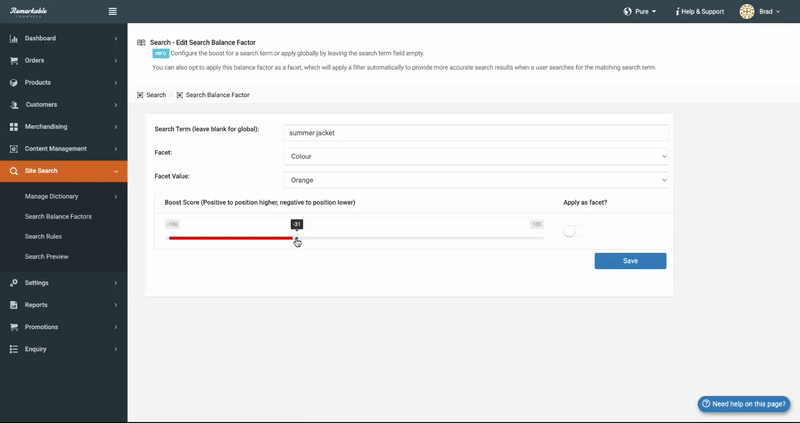Ecommerce Platform Battles: Shopify Plus vs Remarkable Commerce
A retailers technology stack choice will set the path for their digital performance, so choosing wrongly can be truly disastrous. Yet re-platforming is a huge undertaking for any retailer and should not be underestimated, however, it is commonly a requirement for growth – as many retailers will see small (or even negative) growth year-on-year, and will have hit the ceiling of capabilities of their current platforms.
As one of the most popular, fastest-growing commerce platforms in the market today, Shopify is often one of the most popular choices when reviewing eCommerce platform providers – and more commonly now, in the enterprise space too.
Shopify offers their ‘Shopify Plus’ proposition to small/mid-sized businesses looking for ease of use, a quick turnaround to launch their site and a good level of control. However, the trade-off is the limited flexibility and lack of customisation abilities.
Truth is, some of the largest retailers in the UK use these platforms to power their retail experiences – but the question remains, how much potential is being left on the table because of the known limitations.
So, what are the core differences and comparisons between these platforms? Below we review the most common features and popular questions.
1. Cost of ownership
Remarkable Commerce: The Remarkable Commerce platform is fully tailored for each retailer and therefore is not an ‘off the shelf SaaS’ product as its competitors are. The license fee is simply based on average monthly sessions, with tiered price bands – there are no GMV/commission fees. Build costs start at £50,000. The license fee covers unlimited use of the Remarkable Commerce platform for an unlimited number of admin’ users, unlimited amount of API calls and several product variations, telephone and email technical support during office hours, server maintenance, database maintenance, error log maintenance, third-party maintenance and browser maintenance.
Shopify Plus: Shopify entry-level options depend on the number of users and locations; Basic Shopify, Shopify and Advanced Shopify are available. With Shopify Payments, which is available in some countries, 0% transaction fees apply. For enterprise-level Shopify Plus minimum monthly fees start at £1,575 plus GMV (between 0.8% and 1.8%). Build costs for larger sites typically range between £30,000 and £100,000, depending on requirements. Again, development agency costs are in addition.
2. Market sector
Remarkable Commerce: UK Medium-sized B2C retailers – with turnover between £5m and £50m p/a. Particular sectors include fashion and apparel, sporting equipment, luxury jewellery and toys. The technology agility attracts the attention of retailers from many sectors, as the platform allows for infinite options and limitless configurations.
Shopify Plus: Non-complex medium-sized B2C retailers, especially fashion and lifestyle. Typically Shopify Basic retailers grow with the platform and organically move onto Plus. There are around 100,000 Shopify stores globally and 5,000 of them are Shopify Plus – this highlights the scale of small stores which remain small, or more often than not, are launched but swiftly closed down.
3. Integration partnerships
Remarkable Commerce: The Remarkable Commerce platform has over 300 integrated solutions, covering a wide range of technology types. Although the integrations are not self-serving in the admin, all historic integrations are fairly plug-and-play and available with a short amount of development time. https://remarkable.net/integrations/ the full list of integrations, updated annually.
Shopify Plus: The Shopify https://apps.shopify.com/ is vast and has many complementary systems. Over 80% of Shopify merchants say they rely on apps to run their business. Each of these important apps is a separate piece of code, which can at any time, require maintenance or stop working. Additionally, there is a commercial impact of relying on many apps – especially those which take a commission based on usage.
4. APIs and architecture
Remarkable Commerce: True innovation and development agility is possible when your eCommerce platform can be integrated with any solution and data can be accessed in real-time both manually and dynamically – this is why an open API is critical and is why Remarkable Commerce has a suite of APIs which can be used in a headless fashion to retrieve and post data to. Headless architecture and simple, API integrations give you the flexibility to engage customers across every retail touchpoint – web, mobile, apps, marketplaces, in-store – and deliver seamless omnichannel experiences. Remarkable Commerce has a pre-integrated front end accelerator that slashes ‘time to web’ for new digital storefronts, so you can focus on UX, brand strategy and optimisation.
Shopify Plus: Shopify is trying to dress their ‘Plus’ platform up as a “modular monolith” but the truth, is the platform can be hacked together, using script feature hacks in an attempt to resolve issues like complex product pricing, promotions, and custom checkout flows. In recent years, Shopify has heavily promoted its ‘Headless’ capabilities, but there are many complexities that arise with headless. More often than not, headless projects shouhld only be approached in very particular circumstances.
5. Product & catalogue management
Remarkable Commerce: With an endlessly customisable admin (and storefront!), all Remarkable Commerce platform clients have heavily tailored functionality which saves them time and effort, when managing large amounts of products and categories. A few popular features inside the PIM module of Remarkable Commerce include a product translations interface: allowing the retailer to bulk set translated copy.
Shopify Plus: A common frustration with Shopify is that when you upload product images, they aren’t automatically re-cropped or processed to a suitable size/dimension. This will need to be done manually. While you can overcome this by editing your images before uploading, it (again) becomes a time-consuming task when you’re working with 100s or even 1000s of products. One of the biggest challenges you may face when working with Shopify, is your agency are unable to access server logs and historical data. Such as if you accidentally import incorrect product data, you cannot revert (or even ask your agency to revert the change back to a previous data iteration).

6. Order management
Remarkable Commerce: The OMS module in the Remarkable Commerce platform has many customisable fields and functions, with the base solution including Bulk Orders Management, Returns and Refunds Management, Custom Order tagging, Management of Order status emails, Bespoke Invoicing, Automated Courier Tracking, Automated Payment Tracking, Manual Order (MOTO) functions for Customer Service teams and a full suite of advanced reporting.
Shopify Plus: Shopify has streamlined its order management solution to consider the standard nuances of payments, refunds, gift cards and discounts. On top of this, Shopify retailers have the option to use the SFN (Shopify Fulfilment Network) – a white-labelled 3rd party logistics solution, competing against Amazon’s FBA ‘Fulfilled by Amazon’ proposition. There are clear commercial disadvantages of using this solution if you are protective over order margin and your P&L.
7. Extensibility and flexibility
Remarkable Commerce: One of the biggest USPs of Remarkable Commerce is how extendable the platform is. This is achievable because each retailer who uses the Remarkable Commerce Platform has a tailored version of the storefront, that is connected through APIs, to their fully-custom admin/control panel. Both the frontend and the admin are commonly extended to include additional modules, functions and connectors. With full access to every line of architecture code, the Remarkable Commerce agency team have no limitations or restrictions, leading to infinitely customisable customer experiences.
Shopify Plus: Related to the Shopify Plus core CMS limitations are its inherent backend development limitations. It’s true that Shopify Plus allows a small amount of flexibility on the front end (even more so if you go down the headless route), but any integration on the backend has to work with their API. If you are using a specific inventory or fulfilment provider and their information doesn’t integrate via Shopify’s API, then you will struggle. As a hosted platform, you don’t have FTP or database access. Everything has to go through the front end or via the API. For some brands and IT departments, that can present a risk and be an inherent disadvantage compared to owning (or at very least, having full access) to the full technology stack.
8. Admin Ease of Use
Remarkable Commerce: The Remarkable Commerce Manager (admin portal) has been moulded over the last 20+ years, with the direction and direct input from clients of various sizes – this has led to a comprehensive and easy to use platform, where a retailer can complete key actions much quicker than other platforms. An example of this is promotion/campaign setup and launching, which can be achieved within minutes. Each client has a tailored version of the core admin where they request function and UX updates – ultimately leading the development roadmap for their own version.
Shopify Plus: In comparison to the standard Shopify admin, ‘Plus’ users gain access to the enhanced organisation version of the admin. This allows for retailers to use the self-serve functions like ‘Shopify Flow’, but also manage multiple stores at the organisation level (however, there are many known limitations for managing multi-store architecture and technical configurations).
9. SEO (Search Engine Optimisation)
Remarkable Commerce: Remarkable Commerce is a totally bespoke platform so the admin can be tailored to suit your needs within the build phase. Due to it being flexible, it allows for custom rules and logic to be created to automate certain features that influence SEO, such as a product retirement strategy. It doesn’t, however, have plugins and any mar-tech integration would be actioned as a development project.
Shopify Plus: Shopify Plus is another good platform to use to update on-page SEO elements and has a wide range of plugins that can be used to help you quickly implement on-page and technical SEO changes. It does, however, become reliant on Javascript to utilise its filtering/ product grids which may influence how quickly pages are crawled and indexed. It also has a fairly rigid URL structure so you are limited with how you structure your URLs.
10. Roadmap
Remarkable Commerce: Each retailer who uses the Remarkable Commerce Platform has their own unique roadmap of storefront and admin new functionality, change requests and version updates. This enables every retailer to take their own direction but also benefit from the larger frequent platform updates that every client receives.
Shopify Plus: With an annual roadmap & large partner events attended by thousands of agencies and retailers to announce their plans, Shopify is extremely transparent about their plans – with many modules and functions of their admin seeing small regular updates. The benefit of a SaaS solution like Shopify Plus is you will receive and benefit from broad general updates made throughout the year, yet have very little control or influence on the said roadmap. Their general direction is towards building an ecosystem of technology aimed squarely at small-mid sized retailers, who are looking to connect their online and offline customers.

11. Internationalisation
Remarkable Commerce: Retailers need the ability to change, adapt and launch as quickly as possible, without needing to repeat tasks. This is the reason that we created functionality for retailers to launch promotions across multiple sites, apply configuration updates to multiple sites and publish content updates to selected sites in real-time. Removing restrictions, improving efficiencies and enabling revenue growth.
Shopify Plus: As Paul Rogers says, Shopify Plus is “not currently a good fit for international eCommerce businesses… heavy reliance on 3rd party sync’s and solutions…”. The biggest management overheads and time-consuming tasks when running an International Shopify Plus setup are: key trading functions like Visual Merchandising needs to be actioned individually for each site and creating promotions has to be done at a store level too – not a global level. There are many UK retailers who sell internationally using Shopify Plus (like Ring.com, Gymshark.com and VictoriaBeckham.com) – however, the question remains, how much performance benefit is being left ‘on the table’ due to the limitations.
12. Storefront Speed, Performance and UX
Remarkable Commerce: With an obsession with site speed and storefront performance, the frontend developers at Remarkable Commerce pay particular attention to speed metrics and regularly undertake speed audits, to review what area of code can be optimised further. This continuous exercise ensures that our clients are providing the very best customer experience and quickest sites possible.
Shopify Plus: Anyone running a Shopify store knows that they have to use a multitude of third-party apps. But many of these apps run scripts on web pages which reduce Shopify page speed. However, even if you uninstall an app, the code does not fully remove itself from your site and will continue to bloat until manually removed. Up until 2019, the standard Shopify storefront has based on a code framework that was originally created 15 years previous and lived within Shopify’s Ruby on Rails monolith. Over the course of 2019 and 2020, Shopify moved towards a new rendering solution that engaged a routing module (which they named the Lua routing module) and dynamically routed requests to their new implementation. This gradual roll-out is still in progress for their 500,000 storefronts – proving the slowness of the platform development.
Conclusion
The question of what eCommerce platform to use (or migrate to) is always a really tough decision for any business to make, especially when the retailer has a turnover above £50m p/a – as there is a lot more budget at stake, more stakeholders involved etc. Enterprise eCommerce solutions don’t come cheap and they require a huge amount of time (and a lot of people) to implement, run and maintain. This is why it’s incredibly important that you remain highly organised and systematic in your research and decision-making process, as selecting the wrong platform can have a huge impact on your business.
Ultimately, a retailers platform choice should be in line with both their current online performance and their growth ambitions. There are many pros and cons for both Shopify Plus and BigCommerce, and where one excels, the other underperforms. For retailers with a turnover above £5m p/a and considering a platform move, https://remarkable.net/commerce-platform/ to learn more about the Remarkable Commerce Platform.

















